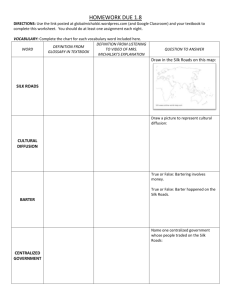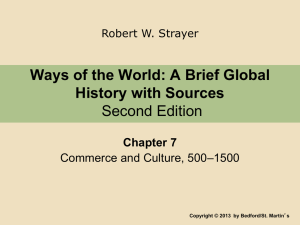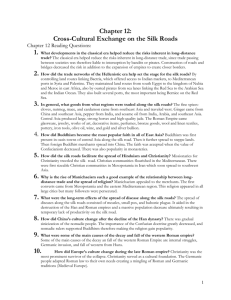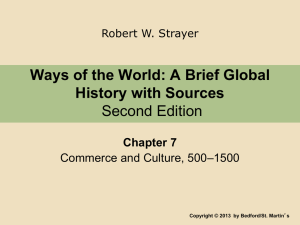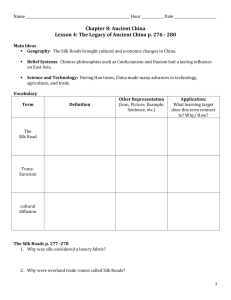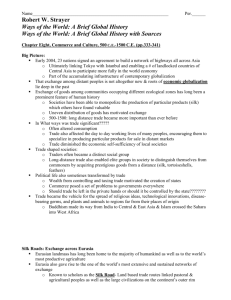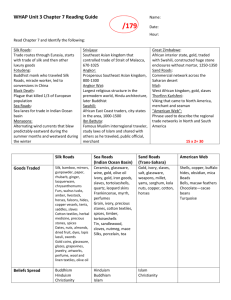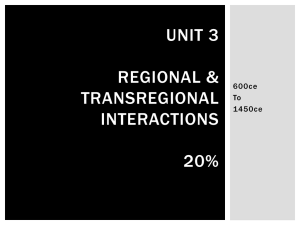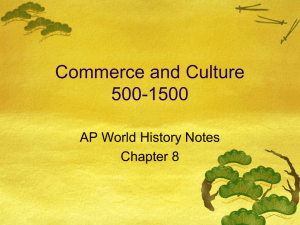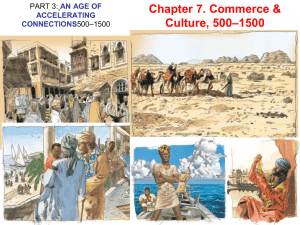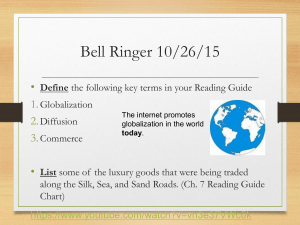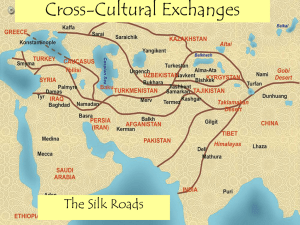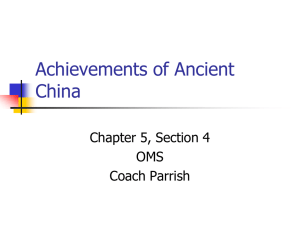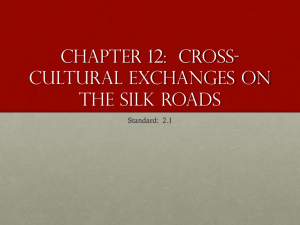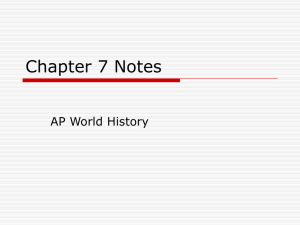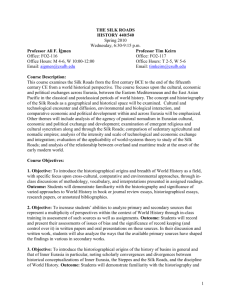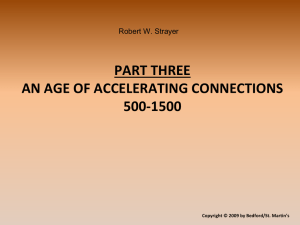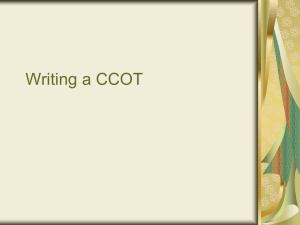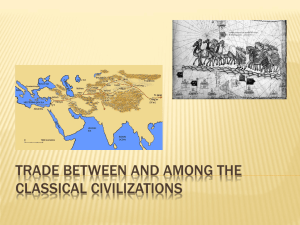Chapter 8: Commerce and Culture
advertisement
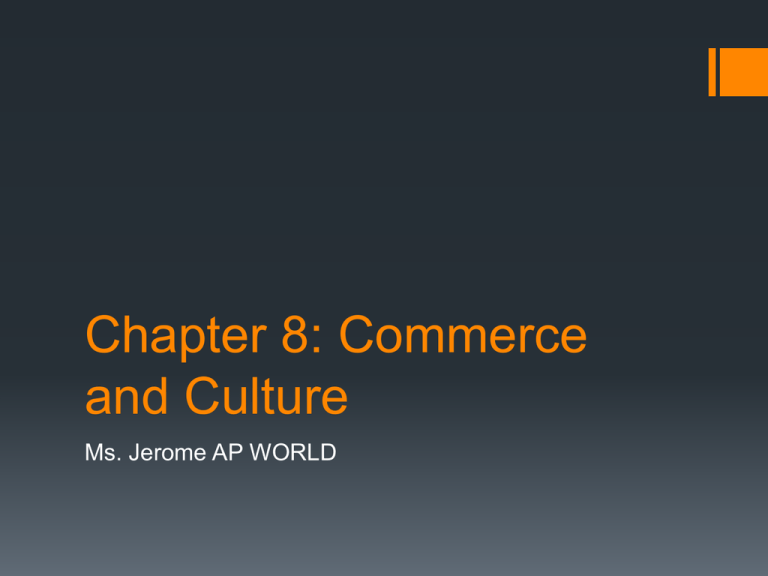
Chapter 8: Commerce and Culture Ms. Jerome AP WORLD Big Picture Questions What motivated and sustained the long distance commerce of the Silk Roads, Sea Rods, and Sand Roads? Why did the Eastern Hemisphere develop long distance trade more extensively than did the societies of the Western Hemisphere In what ways did commercial exchange foster other changes? In what ways was Afro Eurasia a single interacting zone, and in what respects was it a vast region of separate cultures and civilzations? Why was trade significant? 1. altered consumption 2. encouraged specialization 3. diminished economic self-sufficiency of local societies 4. traders often became a distinct social group 5. sometimes was a means of social mobility 6. provided prestige goods for elites 7. sometimes the wealth from trade motivated state creation 8. religious ideas, technological innovations, plants and animals, and disease also spread along trade routes SILK ROADS Eurasia –majority of humankind, world’s most productive agriculture, largest civilizations, greatest concentration of pastoral peoples. Gave rise to most extensive ans sustained network of exchange among diverse people Silk Roads– land based trade routes linked pastoral and agricultural peoples “relay trade” Unity and coherence in Eurasia The Growth of the Silk Roads Beginnings lay in geography and history Eurasia divided into inner and outer zones—different environments Outer Eurasia—relatively warm, well water areas, good for farming, great (China, India, Middle East, Mediterranean) Inner Eurasia—eastern Russia and Central Asia-harsher and drier climates. Not conducive to agriculture Inhabited by pastoral people Raided agricultural neighbors of the south Movement of pastoral people served to diffuse Indo-European languages, metallurgy, horse based technologies all over Eurasia Continued Classical Civilizations By early centuries of the Common Era, there was a network of transcontinental exchange, often brokered by pastoral peoples trading networks did best when large states provided security for trade…Examples: a. Roman and Chinese empires anchored commerce b. in seventh and eighth centuries, the Byzantine Empire, Abbasid dynasty, and Tang dynasty created a belt of strong states c. in thirteenth and fourteenth centuries, Mongol Empire controlled almost the entirety of the Silk Roads Goods in Transit-economic component a vast array of goods traveled along the Silk Roads, often by camel mostly luxury goods for the elite high cost of transport did not allow movement of staple goods Silk Moved east to west silk symbolized the Eurasian exchange system at first, China had a monopoly on silk technology Considered morally decadent in Rome Central Asia—silk used as currency Became sacred in Buddhism and Christianity Cultures in Transit Conduit of culture Buddhism in particular—product of Indian civilization spread to Central and East Asia Buddhism appealed to merchants who preferred its universal message over Brahmin dominated Hinduism which privileged the high caste Buddhism spread to oasis cities of Central Asia. Buddhism took off Merchants introduced it to China Struggled to spread where culture lacked literacy Buddhism Changes Originally shunned materialism Buddhist monasteries in rich oasis towns of the Silk Roads became involved with secular affairs Monasteries became wealthy In areas influenced by Alexander—Buddha looks Greek Buddha becomes a deity Disease in Transit Devastating consequences Mongol Empire—unified much of the Eurasian landmass Era of intensified interaction Spread the Black Death –bubonic plague Between 1346 and 1350 1/3 of the population of Eurrope perished from plague Tenant farmers and urban workers were now in higher demand Sea Roads: Indian Ocean Connected people on eastern Hemisphere Transportation cheaper on sea roads Carried more bulk goods Monsoons—alternating wind currents blew predictable eastward during the summer months and westward during the winter. Sea Trade Began early civilizations Tempo of trade picked up during classical civilizaitons and post classical Mariners learned how to ride the monsoons India was at the epicenter of trade Who encouraged trade? CHINA and ISLAM The new dynasties of China (Tang and Song) reestablished an effective and unified state –encouraged maritime trade China provided a vast market of goods China had great ships –magnetic compass to help … Islam Unlike Confucian culture which was anti merchant—Islam was friendly to commercial life. Prophet Muhammad was a trader Arab Empire—from Atlantic through Mediterranean basin to India A single political system and traditions favorable to Muslim traders Srivijaya and Swahili City States South east Asia and East Africa Srivijaya Between India and China Main participant in Indian Ocean trade Grew as a major center of Buddhist observance Swahili City States East Africa Commercial city states Islam brought trade to East Africa like never before New opportunities for wealth– gold, ovory, quartz, leopard skin, slaves Villages became bustling towns and chiefs became kings. Developed independent city states No imperial system Not like Srivijaya as one controlling force Sand Roads Sand Roads The Camel—could go for days without wter made it possible for long trek across Sahara Started in 300 Muslim North African Arabs organized caravans across the desert Sought GOLD Sahara no longer a barrier to trade
